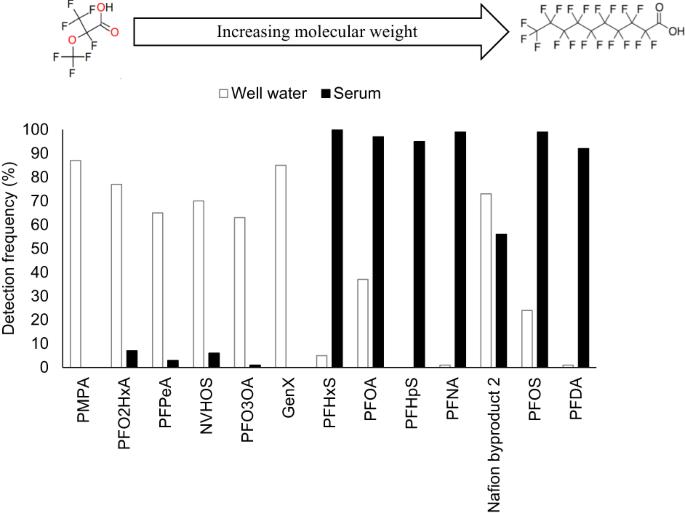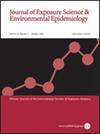Per- and polyfluoroalkyl ether acids in well water and blood serum from private well users residing by a fluorochemical facility near Fayetteville, North Carolina
IF 4.1
3区 医学
Q2 ENVIRONMENTAL SCIENCES
Journal of Exposure Science and Environmental Epidemiology
Pub Date : 2024-01-10
DOI:10.1038/s41370-023-00626-x
引用次数: 0
Abstract
A fluorochemical facility near Fayetteville, North Carolina, emitted per- and polyfluoroalkyl ether acids (PFEAs), a subgroup of per- and polyfluoroalkyl substances (PFAS), to air. Analyze PFAS in private wells near the facility and in blood from well users to assess relationships between PFEA levels in water and serum. In 2019, we recruited private well users into the GenX Exposure Study and collected well water and blood samples. We targeted 26 PFAS (11 PFEAs) in water and 27 PFAS (9 PFEAs) in serum using liquid chromatography-mass spectrometry. We used regression modeling to explore relationships between water and serum PFAS. For the only PFEA detected frequently in water and serum, Nafion byproduct 2, we used generalized estimating equation (GEE) models to assess well water exposure metrics and then adjusted for covariates that may influence Nafion byproduct 2 serum concentrations. We enrolled 153 participants ages 6 and older (median = 56 years) using 84 private wells. Most wells (74%) had ≥6 detectable PFEAs; median ∑PFEAs was 842 ng/L (interquartile range = 197–1760 ng/L). Low molecular weight PFEAs (PMPA, HFPO-DA [GenX], PEPA, PFO2HxA) were frequently detected in well water, had the highest median concentrations, but were not detectable in serum. Nafion byproduct 2 was detected in 73% of wells (median = 14 ng/L) and 56% of serum samples (median = 0.2 ng/mL). Cumulative dose (well concentration × duration at address) was positively associated with Nafion byproduct 2 serum levels and explained the most variability (10%). In the adjusted model, cumulative dose was associated with higher Nafion byproduct 2 serum levels while time outside the home was associated with lower levels. PFAS are a large class of synthetic, fluorinated chemicals. Fluorochemical facilities are important sources of environmental PFAS contamination globally. The fluorochemical industry is producing derivatives of perfluoroalkyl acids, including per- and polyfluoroalkyl ether acids (PFEAs). PFEAs have been detected in various environmental samples but information on PFEA-exposed populations is limited. While serum biomonitoring is often used for PFAS exposure assessment, serum biomarkers were not good measures of long-term exposure to low molecular weight PFEAs in a private well community. Environmental measurements and other approaches besides serum monitoring will be needed to better characterize PFEA exposure.

北卡罗来纳州费耶特维尔附近一家氟化工厂附近私人水井用户的井水和血清中的全氟和多氟烷基醚酸。
背景:北卡罗来纳州费耶特维尔附近的一家氟化工厂向空气中排放了全氟和多氟烷基醚酸 (PFEAs),这是全氟和多氟烷基物质 (PFAS) 的一个子类:分析设施附近私人水井中的 PFAS 和水井使用者血液中的 PFAS,以评估水和血清中 PFEA 水平之间的关系:2019 年,我们招募了私人水井使用者参与 GenX 暴露研究,并收集了井水和血液样本。我们使用液相色谱-质谱法检测了水中的 26 种 PFAS(11 种 PFEA)和血清中的 27 种 PFAS(9 种 PFEA)。我们使用回归模型来探讨水和血清中 PFAS 之间的关系。对于唯一在水中和血清中频繁检测到的全氟辛烷磺酸--纳菲昂副产物 2,我们使用了广义估计方程 (GEE) 模型来评估井水暴露指标,然后对可能影响纳菲昂副产物 2 血清浓度的协变量进行了调整:我们招募了 153 名年龄在 6 岁及以上(中位数 = 56 岁)、使用 84 口私人水井的参与者。大多数水井(74%)中可检测到的全氟乙烯醚≥6个;∑全氟乙烯醚中位数为842纳克/升(四分位间范围=197-1760纳克/升)。井水中经常检测到低分子量全氟乙烯(PMPA、HFPO-DA [GenX]、PEPA、PFO2HxA),中位浓度最高,但在血清中未检测到。在 73% 的井水样本(中位数 = 14 纳克/升)和 56% 的血清样本(中位数 = 0.2 纳克/毫升)中检测到了 Nafion 副产物 2。累积剂量(油井浓度 × 地址持续时间)与 Nafion 副产物 2 血清水平呈正相关,并能解释最大的变异性(10%)。在调整模型中,累积剂量与较高的纳菲昂副产物 2 血清水平相关,而离家时间与较低的纳菲昂副产物 2 血清水平相关:影响:PFAS 是一大类合成含氟化学品。氟化工设施是全球环境 PFAS 污染的重要来源。氟化学工业生产全氟烷基酸的衍生物,包括全氟烷基和多氟烷基醚酸 (PFEAs)。在各种环境样本中都检测到了全氟烷基醚,但有关暴露于全氟烷基醚的人群的信息却很有限。虽然血清生物监测通常用于评估 PFAS 暴露情况,但血清生物标志物并不能很好地衡量私人水井社区长期暴露于低分子量 PFEAs 的情况。除了血清监测外,还需要环境测量和其他方法来更好地确定全氟乙烷暴露的特征。
本文章由计算机程序翻译,如有差异,请以英文原文为准。
求助全文
约1分钟内获得全文
求助全文
来源期刊
CiteScore
8.90
自引率
6.70%
发文量
93
审稿时长
3 months
期刊介绍:
Journal of Exposure Science and Environmental Epidemiology (JESEE) aims to be the premier and authoritative source of information on advances in exposure science for professionals in a wide range of environmental and public health disciplines.
JESEE publishes original peer-reviewed research presenting significant advances in exposure science and exposure analysis, including development and application of the latest technologies for measuring exposures, and innovative computational approaches for translating novel data streams to characterize and predict exposures. The types of papers published in the research section of JESEE are original research articles, translation studies, and correspondence. Reported results should further understanding of the relationship between environmental exposure and human health, describe evaluated novel exposure science tools, or demonstrate potential of exposure science to enable decisions and actions that promote and protect human health.

 求助内容:
求助内容: 应助结果提醒方式:
应助结果提醒方式:


